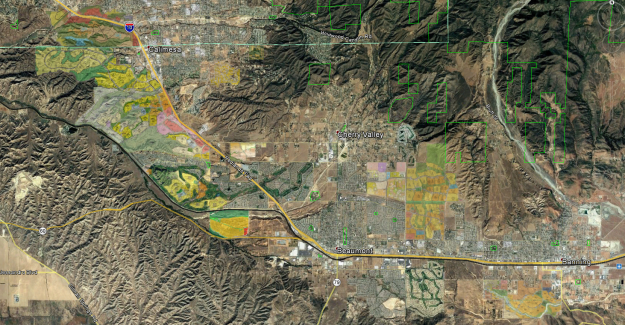I’ve written a few posts wondering why there’s no housing boom the Inland Empire. Prices have recovered, the zoning is there for it, and there’s limited opportunity to build in Los Angeles & Orange Counties. I started working on this next post as another entry in that series, to show all the approved residential master plans that are out there but not being built.
However, in the last couple months, there has been a noticeable increase in the number of permits pulled for housing construction in the IE.

June 2017 saw 2,076 permits, the first time since August 2007 that the number of permits in a month has been over 2,000. It appears that the IE’s lost decade of housing production might be over. Single-family builders are going to be wrapping up the timid completion of developments in partially built projects, and looking for bigger opportunities. So instead of asking why these residential master plans aren’t being built, consider this a field guide to what might be happening in the next few years.
Chino & Ontario
The closest greenfield developments to LA & OC are probably the best candidates to boom. In Chino there’s a plenty of space to build in The Preserve, and Ontario has a huge amount of development potential in Ontario Ranch.
The map below shows the approved master plans with Chino at the bottom and Ontario at top. I overlaid these from the planning documents, so the colors are not entirely consistent from plan to plan, but they follow the same pattern. Yellow and light orange are single-family, dark orange and brown are multi-family, red is commercial, purple is mixed use, blue is public (schools etc), and green is open space. For reference, the distance between Archibald Ave & Milliken Ave is 2 miles.

Chino & Ontario provide (relatively) easy access to LA & OC, via the 71 north and 60 west to LA, and the 71 south and 15 south to OC. Riverside County is planning to start construction later this year on express lanes on the 15 from the 60 south to the 91, which will make commuting from Ontario Ranch more appealing.
Fontana & Rialto
Further north and east, there’s still a fair amount of undeveloped land in the northern parts of Fontana & Rialto. Fontana’s recently approved Westgate specific plan, near the junction of the 210 and the 15, allows for up to 3,248 dwelling units. Further up the 15, another set of plans allow another 5,000 units. Across Sierra Ave in Rialto, near the top of the image, Lennar is finishing up development in Rosena Ranch, and DR Horton is building the first neighborhood in Lytle Creek Ranch, zoned for 8,400 dwelling units. The distance from Sierra to Citrus is 1 mile.

Lake Elsinore
Heading the other direction on the 15 from Chino & Ontario, south to Lake Elsinore, there are master plans north and south of downtown ready to go, with several thousands of units of potential.

Perris & Menifee
Moving east to the 215 corridor, there are also plenty of developments that could be built. Between Parkwest, Green Valley, Riverglen, & Riverwoods, there is zoning for over 8,000 dwelling units. The Menifee North plan, beween Romoland and Homeland, allows about 2,800 units. And Winchester Hills on Domenigoni Parkway a few miles east of the 215, which has been frozen in time for almost a decade, allows over 5,000 units. The distance from the 215 to Menifee Rd is 2 miles.

We’ll know the IE is back for sure when construction starts on a big project east of the 215. The big projects have been dormant for a long time. But with the closer-in developments in Menifee nearing completion, how long can that last?
Yucaipa to Banning
East of San Bernardino, there’s a string of approved plans in Yucaipa, Calimesa, Beaumont, and Banning. Combined these will allow almost 20,000 dwelling units. The bottom of the large plan east of Beaumont is 1 mile wide.

There’s Lots of Development Capacity in the IE
This is just a sampling of the master plans that are approved for construction in the IE, and doesn’t even account for any of the development that can occur under the normal zoning in the many places not covered by a specific plan.
In previous posts in this series, I’ve argued that zoning is not the defining restriction on development in the IE. This is in contrast to LA & OC, where sky-high prices suggest that upzoning would unleash a large amount of development. Issues in the IE seem to relate more to land costs and impact fees, but perhaps prices have hit a tipping point where these obstacles can be overcome. If so, expect to see the number of housing permits issued in the IE continue to rise.
